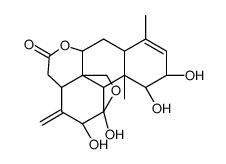Ailanthone
Modify Date: 2025-08-22 18:27:26

Ailanthone structure
|
Common Name | Ailanthone | ||
|---|---|---|---|---|
| CAS Number | 981-15-7 | Molecular Weight | 376.400 | |
| Density | 1.5±0.1 g/cm3 | Boiling Point | 641.0±55.0 °C at 760 mmHg | |
| Molecular Formula | C20H24O7 | Melting Point | N/A | |
| MSDS | N/A | Flash Point | 231.6±25.0 °C | |
Use of AilanthoneAilanthone (Δ13-Dehydrochaparrinone) is a potent inhibitor of both full-length androgen receptor (AR) (IC50=69 nM) and constitutively active truncated AR splice variants (AR1-651 IC50=309 nM). |
| Name | ailanthone |
|---|---|
| Synonym | More Synonyms |
| Description | Ailanthone (Δ13-Dehydrochaparrinone) is a potent inhibitor of both full-length androgen receptor (AR) (IC50=69 nM) and constitutively active truncated AR splice variants (AR1-651 IC50=309 nM). |
|---|---|
| Related Catalog | |
| Target |
IC50: 69 nM (Full-length androgen receptor), 309 nM (AR1-651)[1] |
| In Vitro | Ailanthone is a potent inhibitor of both full-length AR (AR-FL) and constitutively active truncated AR splice variants (AR-Vs). Ailanthone binds to the co-chaperone protein p23 and prevents AR's interaction with HSP90, thus resulting in the disruption of the AR-chaperone complex followed by ubiquitin/proteasome-mediated degradation of AR as well as other p23 clients including AKT and Cdk4, and downregulates AR and its target genes in PCa cell lines and orthotopic animal tumours. In addition, Ailanthone blocks tumour growth and metastasis of CRPC[1]. Ailanthone has been shown to possess an growth-inhibitory effect against several cancer cell lines including HepG2, Hep3B, R-HepG2, Jurkat, HeLa, MCF-7, MDA-MB-231 and A549 cells. Ailanthone inhibits Huh7 cell growth through the induction of mitochondrion-mediated cell apoptosis and G0/G1 cell cycle arrest. Ailanthone-induced apoptosis is mitochondrion-mediated and involved the PI3K/AKT signaling pathway in Huh7 cells[2]. |
| In Vivo | Not only i.p. administration but also p.o. administration of Ailanthone has excellent efficiency for blocking the growth of CRPC xenografts. In pharmacokinetic studies, Ailanthone exhibits good solubility in water and good bioavailability (>20%). In addition, Ailanthone effectively suppresses CRPC tumour growth, despite not reaching a steady state of plasma drug concentration during the course of treatment[1]. |
| Cell Assay | For SRB assay, cells are cultured in complete RPMI 1640 and incubated with indicated concentrations of Ailanthone or cells are maintained in fresh phenol red-free RPMI 1640 medium with 5% charcoal-stripped FBS, 1 nM DHT and indicated compounds. After 48 or 72 h, the cells are then fixed and the cell growth is detected with the SRB assay. For colony formation assay, prostate cancer cells are incubated with indicated concentrations of Ailanthone in complete RPMI 1640 for 2 weeks and then cells are fixed with 4% paraformaldehyde and stained with crystal violet. Colonies are visualized under a microscope, and all of the fields are imaged and counted. Colony formation as a percentage of vehicle control for each cell line is presented[1]. |
| Animal Admin | Mice[1] In orthotopic castration-resistant prostate cancer xenografts model, mice are intraperitoneally injected with Ailanthone (2 mg/kg), MDV (10 mg/kg) or DMSO (as controls). Prostate tumour growth and local metastasis are monitored weekly using the IVIS Imaging System. Images and measurements of bioluminescent signals are acquired and analysed using Living Image and Xenogen software[1]. |
| References |
| Density | 1.5±0.1 g/cm3 |
|---|---|
| Boiling Point | 641.0±55.0 °C at 760 mmHg |
| Molecular Formula | C20H24O7 |
| Molecular Weight | 376.400 |
| Flash Point | 231.6±25.0 °C |
| Exact Mass | 376.152191 |
| PSA | 113.29000 |
| LogP | -0.76 |
| Vapour Pressure | 0.0±4.3 mmHg at 25°C |
| Index of Refraction | 1.640 |
| Storage condition | 2-8C |
CHEMICAL IDENTIFICATION
HEALTH HAZARD DATAACUTE TOXICITY DATA
|
| Precursor 1 | |
|---|---|
| DownStream 0 | |
| Picrasa-3,13(21)-diene-2,16-dione, 11,20-epoxy-1,11,12-trihydroxy-, (1β,11β,12α)- |
| 13,21-Didehydrochaparrinone |
| Ailanthone |
| Picrasa-3,13(21)-diene-2,16-dione, 11,20-epoxy-1,11,12-trihydroxy-, (1β,11β,12α,14ξ)- |
| (1β,11β,12α,14ξ)-1,11,12-Trihydroxy-11,20-epoxypicrasa-3,13(21)-diene-2,16-dione |
| (1β,11β,12α)-1,11,12-Trihydroxy-11,20-epoxypicrasa-3,13(21)-diene-2,16-dione |


